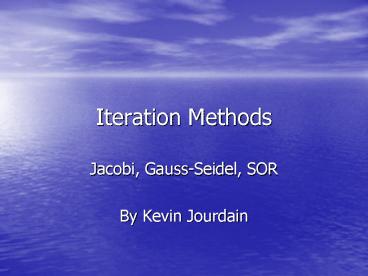Iteration Methods PowerPoint PPT Presentation
1 / 27
Title: Iteration Methods
1
Iteration Methods
- Jacobi, Gauss-Seidel, SOR
- By Kevin Jourdain
2
Introduction
- PDEs Application
- Direct method vs. iteration methods
- Applications of iteration methods
- (a) Electric network consisting of resistors
- (b) Heat-conduction problems
- (c) Particule diffusion
- (d) Certain stress-strain problems
- (e) Fluid, magnetic, or electric potential
3
PDEs Application
- Why are we using iteration methods?
- We use, for example, iteration methods in
- Elliptic PDE
- Parabolic PDE
- Hyperbolic PDE
4
Elliptic PDE
- Once we discretise the PDEs, we obtain a linear
system that a lot of time end up being a
diagonally dominated matrix. This is when we will
use the iteration methods. We will explain why
later on. Example of linear system
5
Direct methods vs. Iteration methods
- During the last Math Night, we talked about
direct methods (Gauss-Jordan). - Today, we will talk about iteration methods.
6
Direct methods
- Theoretically, methods such as Gauss Jordan
elimination will give us exact solutions. - If the system is too big, we will have problems
with - the round-off errors
- The storage capacity of the computer.
- How to solve it ?
7
Iteration Methods
- Iteration repeating a process over and over
until an approximation of the solution is
reached.
8
Advantages
- It is useful to solve certain types of problems
- When the number of unknowns is very large but the
coefficient matrix is sparse, Gauss Elimination
becomes inefficient, and sometimes inapplicable
if the methods are preferred. Additional
advantages of iterative methods include (1)
programming is simple, and (2) it is easily
applicable when coefficients are nonlinear.
Although there are many versions of iterative
schemes, we introduce three iterative methods,
Jacobi iterative, Gauss-Seidel, and
successive-over-relaxation (SOR) methods.
9
Advantages
- Iterative methods can be applied to system as
many as 100,000 variables. Examples of these
large systems arise in the solution of partial
differential equations.
10
Advantages
- Also the amount of storage, as stated earlier,
is far less than directs methods. In our example,
we have - 100,000 100,000 variables for direct
- 3 100,000 2 variables for iteration
11
Advantages
- Applications
- (a) Electric network consisting of resistors
- (b) Heat-conduction problems
- (c) Particule diffusion
- (d) Certain stress-strain problems
- (e) Fluid, magnetic, or electric potential
12
Disadvantages
- Iteration cannot be applied to every system
13
Iteration Methods
- Consider a linear system,
- A is a strictly diagonal dominated matrix, X
unknown vector, b non-homogeneous vector. - Therefore, a sufficient condition for iterative
methods to converge is
14
Iteration Method
- For all i
15
Jacobi Method
- Jacobi iterative method can be derived as the
following
16
Jacobi
- Where
17
Jacobi
- Exact formula obtained earlier
- Therefore, the iteration formula would be
18
Jacobi
- Algebraic form
- Code
19
Gauss-Seidel
- Gauss-Seidel iterative method can be derived as
followed
20
Gauss-Seidel
- Exact formula obtained earlier
- Therefore, the iteration formula would be
21
Gauss-Seidel
- Algebraic form
- Code
22
Gauss-Seidel
- Note
- Jacobi
- Gauss-Seidel
- Gauss-Seidel is a faster method because it uses
the updated solution.
23
SOR
- Successive-Over-Relaxation Method, is a modified
version of the Gauss-Seidel Method - Code
24
Convergence
- The iterative process is terminated when a
convergence criterion is satisfied. One commonly
used stopping criterion, known as the relative
change criteria, is to iterate until
25
Convergence
- Is less than a prescribed tolerance ? gt 0. For
most of cases, maximum iterations time is 30, by
experience. Because of the completeness of Rn,
the limit of X(k) is also in Rn.
26
Conclusion
- Who is faster ??
- And the winner is
27
Conclusion (final)
- SOR !!
- SOR should be faster than the two others,
depending on how we peak geniously our ?.

